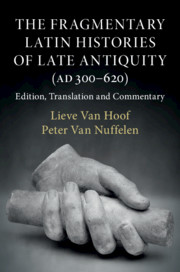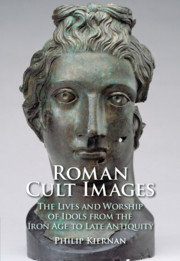Refine search
Actions for selected content:
23990 results in Ancient history
Contents
-
- Book:
- Roman Cult Images
- Published online:
- 15 May 2020
- Print publication:
- 11 June 2020, pp v-vi
-
- Chapter
- Export citation
Abbreviations
-
- Book:
- Roman Cult Images
- Published online:
- 15 May 2020
- Print publication:
- 11 June 2020, pp xv-xvi
-
- Chapter
- Export citation
One - Introduction
-
- Book:
- Roman Cult Images
- Published online:
- 15 May 2020
- Print publication:
- 11 June 2020, pp 1-23
-
- Chapter
- Export citation
Figures
-
- Book:
- Roman Cult Images
- Published online:
- 15 May 2020
- Print publication:
- 11 June 2020, pp vii-x
-
- Chapter
- Export citation
Three - The Birth of Cult Images
-
- Book:
- Roman Cult Images
- Published online:
- 15 May 2020
- Print publication:
- 11 June 2020, pp 85-145
-
- Chapter
- Export citation

The Fragmentary Latin Histories of Late Antiquity (AD 300–620)
- Edition, Translation and Commentary
-
- Published online:
- 04 June 2020
- Print publication:
- 25 June 2020

Roman Cult Images
- The Lives and Worship of Idols from the Iron Age to Late Antiquity
-
- Published online:
- 15 May 2020
- Print publication:
- 11 June 2020
Four - Knowledge (Assemblage): Houses in Pompeii and Herculaneum
-
- Book:
- The Socio-Economics of Roman Storage
- Published online:
- 06 May 2020
- Print publication:
- 14 May 2020, pp 92-121
-
- Chapter
- Export citation
Three - Future (Practice): Silos and Granaries in Gaul and Iberia
-
- Book:
- The Socio-Economics of Roman Storage
- Published online:
- 06 May 2020
- Print publication:
- 14 May 2020, pp 58-91
-
- Chapter
- Export citation
One - Surplus
-
- Book:
- The Socio-Economics of Roman Storage
- Published online:
- 06 May 2020
- Print publication:
- 14 May 2020, pp 1-18
-
- Chapter
- Export citation
Notes
-
- Book:
- The Socio-Economics of Roman Storage
- Published online:
- 06 May 2020
- Print publication:
- 14 May 2020, pp 197-228
-
- Chapter
- Export citation
Plates
-
- Book:
- The Socio-Economics of Roman Storage
- Published online:
- 06 May 2020
- Print publication:
- 14 May 2020, pp ix-x
-
- Chapter
- Export citation
Five - Control (Flow): Warehouses in the Ports of Ostia and Portus
-
- Book:
- The Socio-Economics of Roman Storage
- Published online:
- 06 May 2020
- Print publication:
- 14 May 2020, pp 122-157
-
- Chapter
- Export citation
References
-
- Book:
- The Socio-Economics of Roman Storage
- Published online:
- 06 May 2020
- Print publication:
- 14 May 2020, pp 229-280
-
- Chapter
- Export citation
Two - Needs/Wants (Matter): Villas in Central Italy
-
- Book:
- The Socio-Economics of Roman Storage
- Published online:
- 06 May 2020
- Print publication:
- 14 May 2020, pp 19-57
-
- Chapter
-
- You have access
- HTML
- Export citation
Six - Reproduction (Scale): Family, State, and Accumulation
-
- Book:
- The Socio-Economics of Roman Storage
- Published online:
- 06 May 2020
- Print publication:
- 14 May 2020, pp 158-173
-
- Chapter
- Export citation
Tables
-
- Book:
- The Socio-Economics of Roman Storage
- Published online:
- 06 May 2020
- Print publication:
- 14 May 2020, pp xiii-xiv
-
- Chapter
- Export citation
Dedication
-
- Book:
- The Socio-Economics of Roman Storage
- Published online:
- 06 May 2020
- Print publication:
- 14 May 2020, pp v-vi
-
- Chapter
- Export citation
Copyright page
-
- Book:
- The Socio-Economics of Roman Storage
- Published online:
- 06 May 2020
- Print publication:
- 14 May 2020, pp iv-iv
-
- Chapter
- Export citation
Seven - Epilogue
-
- Book:
- The Socio-Economics of Roman Storage
- Published online:
- 06 May 2020
- Print publication:
- 14 May 2020, pp 174-184
-
- Chapter
- Export citation
